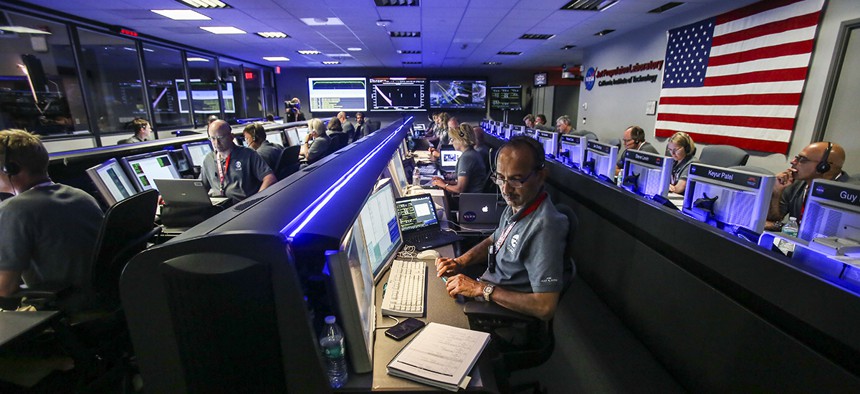NASA Scientists' Most Nerve-Wracking Moment of Juno Mission

Staff members of Juno Mission watch on before the solar-powered Juno spacecraft went into orbit around Jupiter, at NASA's Jet Propulsion Laboratory in Pasadena, Calif., on July 4, 2016. Ringo H.W. Chiu/AP
In their own words.
This week, NASA announced that its solar-powered spacecraft successfully entered orbit around Jupiter, against daunting odds. As the Juno craft begins to collect information about the planet, some of the scientists behind the mission took to Reddit to answer the public’s questions. We have collected some of their comments, edited and condensed for clarity.
How much time and planning goes into a mission such as this?
A huge amount. I personally started thinking about the ideas that eventually became Juno in about the year 2000, after a conversation with Scott Bolton, who had already begun to contemplate the measurements we can do. Our first proposal to NASA was in 2004, and we began designing real hardware in 2006.
As far as backup plans are concerned, we always try to keep a range of possible contingencies in mind. For some of them, we make fairly detailed plans, and for some of the less likely scenarios we might just talk it over for a while and make a few notes about “what if.”
What specific theories about Jupiter are you most looking forward to confirming whether they were accurate or not?
I’m most interested in finding out what lurks beneath Jupiter’s clouds. It’s mind-blowing to think that we don’t yet know what the interior is of the largest planet in the solar system. Is it rocky? Is it metallic? We just don’t know. But that’s exciting, and it’s why we explore.
We’ll use a combination of gravity and magnetic data to disentangle all the different combinations of material that could make up the core (or not). Our web of orbits crossing the planet at different longitudes will be important to build up these interior maps.
We’ve also come to Jupiter looking for clues to its origin and interior, such as the water abundance. We hope to learn about it’s giant magnetosphere and the enormous aurora in the north and south.
Our understanding of how solar systems form is in some chaos (pun intended) due to all the exoplanets we’re finding. Understanding when and where Jupiter formed will help us understand when and where Earth formed with respect to our Sun.
Are the commands to Juno sent in real-time and executed as they reach, or are they pre-programmed?
We normally queue up the commands to the spacecraft well in advance. Occasionally, there are instances when commands are sent in “real time," but definitely not for something as critical as Juno’s orbital insertion.
Right now, it would take a bit more than 45 minutes for a command to reach Juno. That’s how long it takes for radio waves (or light) to reach Jupiter from Earth. Of course, Earth and Jupiter both move so the “one-way light time” will change.
What is the most nerve-wracking part of a mission like this?
For me, launch was the most nerve-wracking part of Juno so far. The Juno spacecraft is the culmination of years of hard work by hundreds of people, and we put it on top of a giant tower of explosives to hurtle it into space. That was just a little scary. After that, orbital insertion was the next most nerve-wracking time, because of the all the unknowns about entering a new environment and performing a critical maneuver at the same time.
Does Jupiter’s massive gravitational pull make it more difficult to keep a probe in orbit?
On the contrary, it helps. When we fired our main engine last night, we were moving at 54.1 km/second. After firing our main engine, we were moving away from Jupiter at 53.7 km/second. That’s still very fast, but that small decrease in orbital speed was enough to put us into a 53-day orbit (instead of just flying by). Jupiter’s pull is so strong, it would be very challenging now to get out of orbit. This wasn’t what I initially expected when the navigators explained to me but it does help demonstrate how different things are when you are around such a massive planet.
When will we get to see images that Juno captures?
The approach movie has been released. Images from Orbit 1 will not be released immediately, because we’ll be doing lots of testing of the camera operations then, but from Orbit 2 and onward (after Aug. 27), our policy will be to release all images in a format that can be read immediately as soon as we get them and this initial processing step is done.
At the end of the planned mission, why will Juno be intentionally destroyed?
We think Jupiter’s icy moon Europa has a subsurface ocean of liquid water; and because everywhere on Earth that we’ve found water, we’ve also found life, this is a good place for us to search. However, we don’t want to go looking for life in the universe only to find that we brought it with us from Earth. We have to abide by something called Planetary Protection. (It’s like the Prime Directive, but real.)





